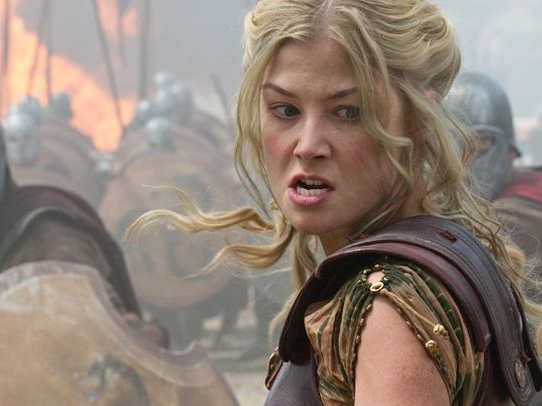Tartarus is the hell of Greek mythology, but in Hollywood remakes it’s as popular a destination as Olympus itself.
Disney and 20th Century Fox sent Hercules and Percy Jackson down to the depths of the underworld. Now Warner Brothers has followed suit with its epic sequel to the 2010 “Clash of the Titans” dubbed “Wrath of the Titans.”
Set a decade after Perseus (Sam Worthington) defeated the Kraken and saved then-princess Andromeda (now played by Rosamund Pike), Perseus is living by the sea, a widower fisherman raising his son Helius (John Bell) alone. In the interim years, the Greeks have stopped praying to the gods almost entirely, and the power of Olympus has greatly diminished because of it.
As their power wanes, the walls of Tartarus that imprison the titan Kronos begin to weaken. When Hades (Ralph Fiennes) and Ares (Édgar Ramírez) join Cronos and capture Zeus (Liam Neeson), Perseus and a band of stalwart soldiers journey to the underworld to rescue him and stop Kronos from unleashing the full wrath of the titan army upon Greece.
All of the characters returning from “Clash,” especially Neeson’s Zeus and Fiennes’s Hades, are essentially unchanged. They’re both stereotypical portraits of the two gods, and that works pretty well. Worthington’s Perseus, like most of his characters, has great brooding eyes and a good action hero physique – all this role really requires. He seems older though, with a son at his side, even if he doesn’t look it.
Pike replaced Alexa Davalos as Andromeda, the quest’s lone feminine influence. An empowered leader, she’s significantly better than either of the lady leads in “Clash.” Newcomer Toby Kebbell as Agenor, a disappointing demigod son of Poseidon, is the wry sidekick with few redeeming values aside from a snide remark about the “Clash” catchphrase, “Release the Kraken.”
This generally needless character is a stereotypical attempt to plug an obvious hole – the film’s general lack of story – with humor. It doesn’t really work. But Bill Nighy as the gods’ forger Hephaestus is a surprising and fun addition to the franchise.
Even with a new script team to develop the sequel, “Wrath” has about as much story as “Clash” did. Dan Mazeau, David Johnson and Greg Berlanti seem to have forgotten that a good plot needs supporting arcs. There are a few very minor ones – Hades questions his decision to betray Zeus, Perseus struggles to keep his son from becoming a warrior – but there’s really nothing to support the journey into Tartarus aside from stylistic CGI – of which there’s plenty.
To reach the underworld, Perseus and his troupe battle the legends of Greece – Cyclops giants, chimeras and Makhai demons with two torsos. They’re a vicious bunch, expertly crafted and depicted. Jonathan Liebesman, director of “Battle: Los Angeles,” is new to the series, and he chooses to showcase the creatures in all their glory, refreshingly avoiding continual quick cuts to instead drinking in the CGI magnificence in longer shots. The action’s pretty solid because of it.
The writers’ fast-track into Tartarus is a labyrinth shortcut created by Hephaestus. It’s an ever-shifting stone tower leading into the bowls of the earth, with thousands of doors and passages opening to death. The scenes inside the labyrinth are gritty, like the rest of Greece, and give the film a good atmosphere.
Complete with a big – if predictable – battle ending, Liebesman’s creation is a great example of the fact that all the wrath of gods and titans can’t quite make a great film out of a B-story, but with enough CGI you can get pretty close.

COMMENTS
Please let us know if you're having issues with commenting.